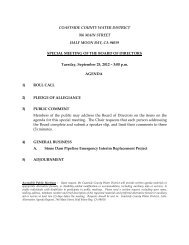Lower Pilarcitos Creek Groundwater Basin Study - Coastside ...
Lower Pilarcitos Creek Groundwater Basin Study - Coastside ...
Lower Pilarcitos Creek Groundwater Basin Study - Coastside ...
Create successful ePaper yourself
Turn your PDF publications into a flip-book with our unique Google optimized e-Paper software.
This is a simplified accounting of what happens to rainfall. However, it can be<br />
tailored to a specific area by taking into account local rainfall amounts, soil conditions,<br />
and ET for different land use conditions (e.g., native vegetation, crops, or landscaping).<br />
This method also can yield insights into the variability of groundwater recharge in<br />
average, wet, and dry years.<br />
Land uses in 1987 and 2002 (representing conditions at the beginning and the<br />
end of the study period) were subdivided into three major categories: urban, open space,<br />
and irrigated agriculture. As described in the Land Use section of this report, urban<br />
areas are estimated to be 32 percent impervious. For the purposes of the water balance,<br />
the remaining 68 percent of the area is assumed to be irrigated landscaping. Similarly,<br />
agricultural areas are estimated to be 96 percent irrigated cropland and 4 percent<br />
impervious. Open space is considered to have no effective impervious area and to be<br />
entirely non-irrigated native vegetation (grass and shrubs). As shown in Table 10, the<br />
land uses can be subdivided according to these percentages and then regrouped<br />
relative to their impervious, irrigated or non-irrigated condition.<br />
Impervious areas provide no significant recharge, so water balance spreadsheets<br />
(see Appendix 7) were developed for two land use conditions: open space/native<br />
vegetation and irrigated landscaping/cropland. Water balances were computed monthly<br />
for the 15-year study period, water years 1987 through 2001. The water balances used<br />
monthly rainfall values from the Half Moon Bay airport climate station, average monthly<br />
ET values for the coastal fog belt zone, and a soil water holding capacity of 6.7 inches.<br />
Full potential ET was applied both to cropland and landscaping, while ET from natural<br />
vegetation was reduced using a coefficient for grassland/sagebrush. Phreatophyte<br />
consumption (estimated as the full potential ET) is addressed separately as a water<br />
balance outflow item.<br />
Table 11 summarizes rainfall and recharge for each year in the study period. As<br />
indicated, the average rainfall recharge rate is greater on the natural vegetation/open<br />
space areas (7.98 inches/year) than on landscaping/cropland areas (5.32 inches/year),<br />
reflecting the lower ET of natural vegetation. For both land use types, annual recharge<br />
ranged from a low of zero in the drought year of 1990 to more than 20 inches in 1998.<br />
Table 12 applies the recharge rates from Table 11 to total acreage values from<br />
Table 10 for 1987 and 2002 land use conditions. As indicated, average recharge from<br />
rainfall amounts to 885 AFY with 1987 land use conditions and 822 AFY given 2002 land<br />
36



